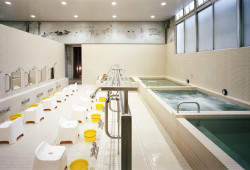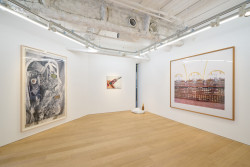
Originally published on metropolis.co.jp on October 2010

Scene from the Steeplechase: The Fallen Jockey, 1866, oil on canvas
Collection of Mr. and Mrs. Paul Mellon; Courtesy of the Board of Trustees, National Gallery of Art, Washington
When you have an exhibition of an artist as famous as Edgar Degas, it’s not enough to just hang up the usual selection of worthy works and roll out the potted biography. For a show like this to really work, the curators must avoid cliché and find something new—or at least less obvious.
“Edgar Degas,” a major retrospective of the 19th-century French Impressionist at the Yokohama Museum of Art, largely succeeds because it finds plenty of fresh things to say about an artist who, like other great masters of the period, perhaps suffers from being too well-known.
This is all to the organizers’ credit because, as the first major retrospective of Degas in Japan for 21 years, whatever they showed would have come across as fresh and interesting to a new generation encountering his artworks for the first time.
Of course, the well-known side of Degas is also on display. There are delightful pictures of ballerinas, like Ballet: The Star (1876-77), which shows Degas’ astounding Impressionist technique applied to the vagaries of stage lighting. Another well-known obsession was horse racing, ably represented by the expansive Scene from the Steeplechase: The Fallen Jockey (1866). Then there are his pastels of nudes, all part of the established canon of Degas’ art.
It would be perverse and, indeed, impossible to exclude such well-known works from a Degas exhibition just because everybody was familiar with them. The important point is not to jettison the famous in the pursuit of pointless novelty, but to cast it in a new light.
Particularly interesting in this case are Degas’ bathing nudes. These present women bent over or crouching as they wash or dry themselves, always for some reason with the face turned away. Although there is something rather voyeuristic about these works, as if the women were being surreptitiously viewed through a keyhole, the main artistic interest is Degas’ ability to evoke the fleshiness and skin tones of his subjects.
Here, the exhibition offers two fresh insights. The first is the theory that Degas gained the confidence to depict nudes in this way from Japanese woodblock prints. This point is made by comparing his nudes to ukiyo-e images that show women in similar postures. As exhibition curator Hideko Numata points out, European artists tended to idealize their nudes.

Two Bathers on the Grass, 1896, pastel on board, 70 x 70cm
©RMN (Musée d’Orsay)/Hervé Lewandowski/distributed by AMF-DNPartcom
“Before this time, bathers in Western art were usually depicted as Venus or some other goddess,” she says. “But Degas showed them the way they are shown in Japanese art.”
The other insight is the artist’s use of photography. In addition to more conventional portraits, Degas employed his camera to capture his nude models in poses later recreated in his paintings. A photo of a woman drying her back from 1896 is unmistakably the figure in the oil painting After the Bath—Woman Drying Herself (1896).
In addition to the expected paintings, pastels and sketches, the exhibition impresses with a good number of sculptures. During his life, Degas only exhibited one sculpture, but after his death in 1917, his heirs found 150 wax pieces in his studio and had many of them cast in bronze. In this medium, too, ballerinas, horses and nudes are the main subjects.
Taken together, Degas’ paintings and sculptures show the artist’s keen interest in dynamics, movement, flesh and muscle. The images in this exhibition continuously resonate with each other—the rounded buttocks of the bathing nudes reminded me of the haunches of the racehorses, whose nimble footwork then brought to mind the poise and athleticism of the ballerinas.
Yokohama Museum of Art
Edgar Degas. Painting. Until Dec 31, free (elem and under)/¥600 (MS)/¥1,200 (HS, univ)/¥1,500 (adult). 3-4-1 Minatomirai, Nishi-ku, Yokohama. Tel: 045-221-0300. Open Fri 10am-8pm, Sat-Wed 10am-6pm, closed Thu. Nearest stn: Sakuragicho or Minato Mirai. www.yaf.or.jp/yma







